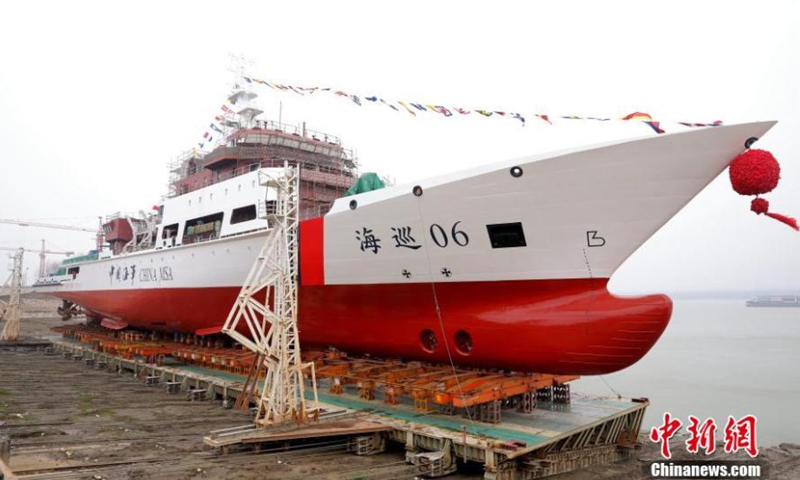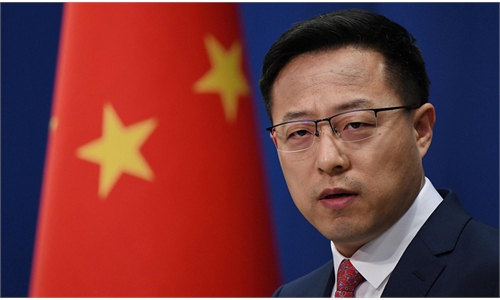
The Haixun 06, a large-scale ocean patrol ship, is launched at a Wuchang Shipbuilding Industry Group Co Ltd shipyard in Wuhan, Central China's Hubei Province, Feb. 8, 2021. The vessel has a designed displacement of 5,560 tons, the first vessel of its size designated to patrol and offer services in the Taiwan Straits.Photo:China News Service
The contest for the laurel of becoming the world's largest shipbuilder between China and South Korea has become more intense, and a South Korean advance in new orders of late serves as a reminder of the need for Chinese shipbuilding companies to ramp up their efforts, and scale up the ladder of value chain in the global shipbuilding business.
South Korea overtook China to become the world's largest shipbuilder in the first quarter of 2021 in terms of new orders, despite that China has led global ship production in all but one year since 2012.
Measured in Compensated Gross Tonnage (CGT) -- a gauge of shipbuilding capacity by weighing more sophisticated ships and less to easier-to-build ships -- South Korean shipyards inked contracts of 5.32 million CGT during the first quarter, surpassing Chinese peers' 4.26 million CGT, according to the Yonhap News Agency.
Runaway steel prices
The argument by a number of Chinese media publications was that the slowness by Chinese shipbuilders was in part caused by the latest wave of price hikes for steel plates in China.
Because of a steep surge in Australian iron ores prices since the second half of 2020 and easing policies by leading economies in the world that had inflated the global commodities market, steel prices in China have gone through the roofs in recent months.
He Xu, director of marketing in State-owned Dalian Shipbuilding Industry Corporation (DSIC) under the China State Shipbuilding Corporation (CSSC) told the Global Times on Friday that the prices of domestic steel plates have soared 35 percent, which affects the shipbuilding costs to some degree and causes the net loss of shipbuilding companies as steel plate costs weigh high in the total costs.
The prices of steel plates in China are higher than in South Korea, which has cut into Chinese companies' business revenues in the global shipbuilding market competition, He said.
An executive from a state-owned shipbuilding company based in Wuhan, Central China's Hubei Province, told the Global Times on Friday that a sudden rise in steel prices - at a pace that shipbuilders could not cope with - has hit domestic shipbuilders particularly hard.
"In normal circumstances, we could factor the rise of raw material prices into contracts with clients," the executive said. "But the current wave of steel price hike is simply too fast and too significant - the prices for steel products have on average risen 2,000 yuan per ton in the past month, which equals a yearly hike in normal years."
"Because ship building contracts are updated at an interval of several months, shipyards could only swallow the price hike at their own expenses. Now we build a ship, we lose money," the executive said.
The global easing of monetary policies and skyrocketing steel prices have put a lot of industrial firms - not just shipbuilders - in limbo, the executive added.
China's status in recent years
China, South Korea and Japan were the world's leading shipbuilders, with China and South Korea taking the bulk share of the market share.
However, the strengths of the three East Asian countries are varied.
A manager from Shanghai-based Hudong-Zhonghua Shipyard, another subsidiary of CSSC, told the Global Times on Friday that among the four main types of civilian vessels in the contemporary world, shipyards from China were building bulk cargo ships and oil tankers. Some Chinese shipyards are able to construct large-sized container ships, and just one shipyard could build membrane type liquefied natural gas (LNG) carriers - the crown jewels of the global shipbuilding industry along with aircraft carriers and luxury cruise ships.
Container ships and LNG carriers are more complicated to build and offer a larger margin and are less prone to the effects of rising steel prices.
The manager maintained that South Korean shipyards particularly benefited from a wave of new orders for large-sized container ships, as the pandemic has altered the landscape of the global shipping industry.
The disruption of local manufacturing capacity in countries hit by pandemic-induced lockdowns and the stranding of containers in the US and EU have given a sharp rise to the demand for new container vessels.
In March alone, Evergreen Marine Corp, a noted company after one of its super-sized container ships blocked the global trade artery the Suez Canal for nearly one week and causing losses measured in billions of US dollars, had placed orders for 25 new container vessels worth $2.5 billion from South Korea's Samsung Heavy Industries.
Higher value ship
South Korea's position of advantage could indeed offer a few lessons to the Chinese shipyards, Chinese experts said, noting that although China is the global No.1 shipbuilder in terms of deadweight tonnage, the East Asian neighbor could serve as a tutor in certain fields.
The manager from Hudong-Zhonghua said South Korean companies had an interdisciplinary partnership to support their shipbuilding industry.
For instance, in building LNG carriers, South Korean companies have a higher localization rate of parts and components, the manager said. In the context of the pandemic, this means Korean shipyards enjoy a faster supply chain, and a speedier service in tuning the equipment and in cost control.
"China should enrich its industrial chain in the direction of supporting higher-value shipbuilding. A wide variety of industries should work in synergy and that would improve the competitiveness of the Chinese shipbuilding industry," the manager said, noting that Chinese shipyards are as good as their South Korean peers, but suppliers of auxiliary parts fall behind.
"It is like two athletes vying for a trophy, China and South Korea have their trump cards," the Wuhan-based executive said.
Measuring such a race by years, not quarters, some analysts in China believe China could surpass South Korea in 2021.
The Chinese shipbuilding industry has been focused on the building of oil tankers, bulk carriers and container ships, Zhang Yongfeng, director of the shipping market analysis department of the Shanghai International Shipping Institute, said.
Zhang noted that Chinese companies possess apparent advantages in low value added dry bulk ships. Due to the bull market expectation of dry bulk, the shipbuilding needs for commodity goods carriers may surge and help China gain leverage over South Korea.
DSIC's He said that the difference of the shipbuilding orders between China and South Korea is slight, and that the intense competition between the two dominant shipbuilders is actually being watered down amid a bonanza of overall orders.
On March 31, DSIC nailed down a contract to build seven large-sized container ships each capable of carrying 16,000 containers, as part of a record-setting deal jointly received with another two CSSC's affiliate companies.
Xiong Xinyi contributed to this story




